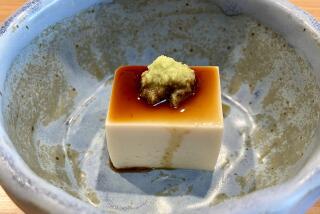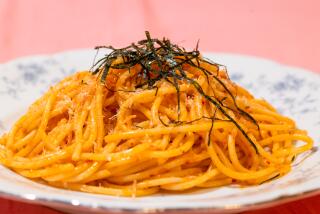Dashi, essence of Japan
At the heart of so much of Japanese cooking is the fragrant broth called dashi. And at the heart of dashi are the delicate pink petals of katsuobushi, shaved flakes of dried bonito fish.
When steeped with the dried seaweed called konbu, katsuobushi gives dashi its irresistible aroma and deep umami flavor. Despite being made in minutes, the stock is the foundation of many Japanese dishes -- miso soup, salad dressings, sauces for noodles, even meat stews.
” Dashi is like the key actor in a movie,” says 83-year-old Chobei Yagi, whose 275-year-old store, Tokyo’s Yagicho Honten, specializes in katsuobushi and other dried foods. “But dashi always plays the supporting role, never the star.”
Most katsuobushi today comes pre-sliced in plastic bags, which is convenient and allows one to make dashi from scratch in less than 15 minutes, but there is another level of truly great katsuobushi -- artisanal arabushi-style katsuobushi and the maturer karebushi- and hongarebushi-style katsuobushi. These are sold in thick blocks, with brown surfaces coated in sun-dried mold. They look more like works of art than food, and maybe they are.
Katsuobushi was originally called kata-uo, or “hard fish,” and at one time every home cook owned a wooden plane, called a katsuobushi kezuriki, to shave what was needed. Store-bought sliced katsuobushi has now become the norm. In the United States, we almost always find only sliced katsuobushi; there just is not enough demand for the old-fashioned whole stuff to import it. It is mostly at specialty stores in Japan, such as Yagicho, where you can buy katsuobushi whole.
And it must be said that while there is nothing that can beat the tantalizing fragrance of freshly shaven bonito flakes, the modern method of packing is so advanced, the sliced petals do taste pretty darn fresh.
The most popular, multipurpose dashi is made with a combination of dried bonito flakes and konbu. The naturally occuring inosinic acid in katsuobushi and glutamic acid in konbu have a synergistic effect on flavor. “One plus one becomes three or more on the umami scale,” says Yagi.
Natural flavors
In modern times, Yagi laments that excessive use of oil, salt and chemically seasoned foods are making Japanese people forget the natural flavors of foods like katsuobushi. “There is nothing so delightful as food made under the sun,” he says.
One place that really cares about preserving the artisanal katsuobushi tradition is the city of Yaezu, Shizuoka, on Surugua Bay near Mt. Fuji, about an hour’s bullet train ride from Tokyo. The production of katsuobushi is one of Yaezu’s main industries; the city has designated the art of making it the artisanal way, mukei bunkazai, or a living cultural treasure.
About 100,000 to 120,000 tons of frozen bonito (also known as skipjack tuna) caught in the South Pacific and frozen on the boat, are brought to the port of Yaezu annually. The imported fish is favored over domestic Japanese bonito because of its lower fat content, which makes the katsuobushi taste milder and less fishy.
Tokuya Kuno, just over 30 years old, is president of Shin Marusho, his family’s 75-year-old katsuobushi factory based in Yaezu, which employees about 80 people. He grew up watching his father and grandfather make katsuobushi and never thought of becoming anything but a katsuobushi producer.
Kuno’s grandfather developed the award-winning Suruga Fubuki (Storm of Suruga) brand. The bonito flakes are light and delicate, resembling the fragile petals of cherry trees in springtime. About 80% of Shin Marusho’s katsuobushi product is the smoke-dried arabushi predominant in the Japanese marketplace.
To make arabushi, the bonito is cut up and cooked, then the fat, scales and bones are removed carefully (and used for fish extracts and fertilizer -- “nothing is wasted,” says Kuno). The fillets are then smoked slowly over mostly oak wood at varying temperatures for several days, with rests in between. The bonito, which can be as large as 6 pounds before cooking, shrinks by about 20% by the time the drying process is complete. On a busy day, one katsuobushi worker may gut, slice and clean as many as 150 bonito.
Different methods
While arabushi takes about 30 days to complete, karebushi and hongarebushi are made by processing arabushi several steps further. Arabushi is reshaped, the “tar” that coats the surface after cooking is removed and then the exterior is deliberately innoculated with a beneficial fungus, aspergillus glacus, in order to reduce the moisture further. The fungus is shaved and the fish is sun-dried repeatedly, three times for karebushi and even more for hongarebushi, taking as long as six months for the block to reach its full maturity.
Karebushi and hongarebushi are favored for the full and elegant aroma they give dashi. Arabushi has a smokier smell; it’s the most popular katsuobushi and is favored by soba and tempura chefs.
Katsuobushi and konbu dashi are made with katsuobushi and a piece of konbu seaweed, which are sold by type -- hidaka, raus, rikyu -- or as dashi konbu. Choose konbu that has some thickness and doesn’t look wafery and fragile. Basically, the two ingredients are steeped in hot water and strained from the broth.
Making fresh dashi is about as easy as infusing tea leaves to make a cup of tea. No wonder miso soup, which is primarily made from dashi, is traditionally served in Japan as a quick breakfast soup.
--
(BEGIN TEXT OF INFOBOX)
Katsuobushi
primer
There are several types of katsuobushi that can be used for different purposes. The best will have light pink or beige shavings that will be slightly shiny. After the packages are opened, the katsuobushi will begin to oxidize and go limp, and the color becomes dull. Katsuobushi is best stored in the freezer.
Hanakatsuo is thin petals that resemble large wood shavings. Some contain chiai (dark meat).
Shaved karebushi makes a flavorful stock full of aroma. It comes with or without chiai. The lighter-colored shavings are suitable for making clear dashi -- ichiban dashi. The darker shavings are suitable for miso soups, simmered dishes and dressings.
Shaved arabushi is the most common type of katsuobushi found in the U.S. and is suitable for making soups, sauces and dressings. The more chiai you see in the shavings, the stronger the flavor.
Arakezuri has thicker shavings than hanakatsuo, with more chiai. Arakezuri produces a rich, strong dashi that is suitable for making braised dishes.
Itokezuri has the thinnest shavings. They are suitable as a garnish for salads and tofu.
Dashi pack is pre-shaved and partially pulverized katsuobushi that is sold in tea bags. It is very popular among Japanese cooks because it is easy to use. It is often combined with other dried ingredients such as konbu, shiitake mushrooms and other fish, such as sardines and mackerel, for a deeper umami flavor.
- Sonoko Sakai
--
Bonito flakes and konbu seaweed dashi
Total time: 40 minutes
Servings: Makes about 7 1/2 cups
Note: The primary dashi is called ichiban dashi, which is used for clear soups and seasoning food. It’s enjoyed for its fragrance and clean flavor. The secondary dashi made with used konbu seaweed and bonito flakes from the primary dashi is called nibanashi. This is also a multi-purpose dashi that is used for miso soups and seasoning foods, but the flavor is blander than the first one. The used konbu can be sliced and eaten straight, in soups or seasoned with soy sauce. The dashi will keep in the refrigerator for three days, or you can freeze it for a month.
1 piece dashi konbu seaweed (6 to 8 inches long)
5 cups loosely packed dried bonito flakes
8 1/2 cups water, divided
1. Using scissors, make several crosswise cuts in the konbu. This helps to extract the flavor during cooking.
2. Place the konbu and 8 cups of water in a large saucepan and set it aside for 10 minutes. Place the pan over medium heat and cook until the water almost comes to a boil, then pluck out the konbu.
3. Keep heating the water to a boil, then remove from the heat. Add one-half cup of cold water. Wait for the liquid to cool a minute or two, then gently add the bonito flakes. Do not stir. When the bonito flakes have settled, about 3 minutes, strain them through a sieve lined with cheesecloth or paper towels. Don’t stir the stock because that will cloud the dashi. The dashi should be aromatic and have a light amber color.
Each 1/2 cup: 0 calories; 0 protein; 0 carbohydrates; 0 fiber; 0 fat; 0 cholesterol; 0 sugar; 0 sodium.
--
Miso soup with crispy age tofu, nappa cabbage and green onions
Total time: 30 minutes
Servings: 4
Note: Do not reheat the miso soup after the miso has been added; the flavor diminishes with reheating. Miso paste is generally available in the Asian sections of well-stocked supermarkets, as well as at Asian markets; age tofu (deep-fried tofu) is available at Japanese markets.
1 quart dashi
3 to 4 tablespoons miso paste (red or white or koji miso paste), or to taste
2 age tofu
1 to 2 leaves nappa cabbage, sliced crosswise into 1/2-inch thick strips, or any greens of your choice.
2 green onions, sliced thinly to garnish
1. In a toaster or using a dry frying pan, lightly toast the age tofu until it’s crispy and slightly toasted but not dry. Slice crosswise into one-half-inch pieces.
2. In a medium saucepan, bring dashi to a boil over medium heat, then reduce the heat to a simmer. Stir in the nappa cabbage and continue to cook for a couple of minutes to wilt the cabbage.
3. Add the miso to the dashi, stirring to blend in until the miso is dissolved. (The miso can be dissolved with a little dashi in a separate bowl before adding it into the dashi.)
4. Just before serving, top the soup with the sliced crisp tofu, and garnish with sliced green onion.
Each serving: 50 calories; 2 grams protein; 7 grams carbohydrates; 3 grams fiber; 1 gram fat; 0 saturated fat; 0 cholesterol; 3 grams sugar; 556 mg sodium.
--
Ohitashi (spinach with dashi dressing)
Total time: 40 minutes, plus soaking time for the spinach
Servings: 3
Note: This is a heavenly light salad that allows you to enjoy the aromatic flavor of dashi. You can substitute spinach with watercress, mizuna, cabbage, sprouts or peas. Light soy sauce and itokezuri (thinly sliced bonito flakes) are generally available at Japanese markets.
1/2 teaspoon salt, plus extra for seasoning the blanching water
1 bunch spinach, root ends untrimmed
3 cups of dashi (see recipe), chilled
1 tablespoon light-colored soy sauce (usukuchi shoyu)
1 teaspoon mirin
Pinch of salt for cooking the spinach
Bonito flakes for garnish (preferably itokezuri)
1. Season a large pot of water with a pinch or two of salt and bring to a boil over high heat. While the water is coming to a boil, prepare an ice bath.
2. Gather the stems of the spinach so the leaves are all facing the same direction. Blanch the spinach until it begins to wilt, about 15 seconds. Remove the bunch from water and immerse it in the ice bath to chill. Drain and set aside.
3. Split the blanched bunch of spinach into thirds. Halve each bunch of spinach and place both halves on a sushi mat, the end of each half pointing in the opposite direction. Roll the spinach in the mat to remove excess water; you may also use your hands to press the excess water out of the spinach roll. Repeat with the remaining two-thirds of the spinach, halving each third and rolling out. The spinach can be made up to this point one day in advance; wrap each of the 3 spinach rolls in plastic wrap and refrigerate until needed.
4. Make the dressing: In a small saucepan, combine the dashi, soy sauce, one-half teaspoon salt and mirin and bring to a boil over medium heat. Remove from heat and set aside until cool.
5. Place the rolls in a non-reactive container and gently pour over the seasoned dashi to cover. Cover the container and soak the spinach rolls in the dashi for 2 to 3 hours in the refrigerator.
6. Just before serving, take the spinach out of the seasoned dashi, trim off the root ends and cut each soaked roll in bite-sized pieces, about 2 1/2 inches in length. Plate each serving in a bowl (you can keep the spinach in its rolled shape, so each cut piece resembles a sushi roll piece, or you can mound the spinach) and pour a few tablespoons of the seasoned dashi over each serving.
7. Serve the spinach garnished with bonito flakes.
Each serving: 33 calories; 4 grams protein; 5 grams carbohydrates; 3 grams fiber; 0 fat; 0 cholesterol; 1 gram sugar; 1,165 mg sodium.
--
Nikujaga (braised sukiyaki-style beef with potatoes and onions)
Total time: 1 hour
Servings: 2 to 3
Note: Nikujaga is a Japanese beef stew that tastes even better the second day, reheated. You can use ichibandashi or the thinner nibandashi for this. Thin slices of pork can be substituted for beef. Thinly sliced sukiyaki-style beef can be found at Japanese markets.
1 pound baking potatoes, preferably smaller
1 small onion
3/4 pound thinly sliced sukiyaki-style beef
2 tablespoons vegetable oil
About 3 cups of dashi (enough to cover the ingredients in the pan)
2 tablespoons sake
1/4 cup mirin
1 tablespoon sugar
4 to 5 tablespoons soy sauce, or to taste
1. Peel and cut the potatoes into bite-size pieces. Place the potatoes in a bowl of water to keep them from browning. Drain before cooking.
2. Peel and slice the onion in half lengthwise, and then cut crosswise into one-half-inch strips.
3. Slice the meat into bite-sized pieces.
4. Heat the oil in a medium-sized pan over medium heat until hot, then add the onions and saute until they are slightly limp but not browned. Add the meat and saute just until colored. Add the potatoes and cook just until lightly colored, about 2 minutes, stirring frequently.
5. Add just enough dashi to submerge the ingredients and increase the heat to high. Stir in the sake, mirin, sugar and 2 tablespoons soy sauce. When the dashi comes to a boil, skim the surface with a slotted spoon to remove the foam, then reduce the heat and gently cook for several minutes until the meat and vegetables are mostly tender. Stir in 2 to 3 tablespoons soy sauce, or to taste, and continue to simmer until the potatoes are cooked through, 4 to 5 minutes.
6. Ladle the meat and vegetables into a bowl, pouring the liquid over. Serve immediately.
Each of 3 servings: 465 calories; 28 grams protein; 41 grams carbohydrates; 3 grams fiber; 17 grams fat; 4 grams saturated fat; 74 mg cholesterol; 13 grams sugar; 1,420 mg sodium.


